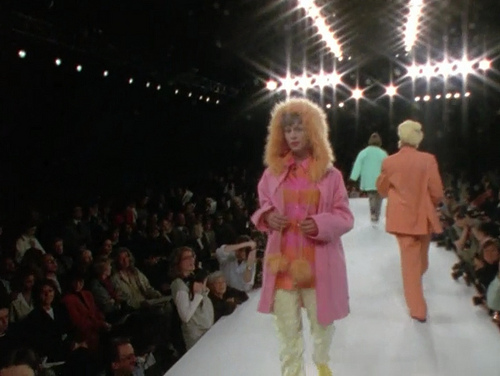Isaac Mizrahi can make things out of tulle or nubuck, but his most fabulous creation is the one he has made of flesh and blood. It is Mr. Mizrahi’s hilarious, happily Napoleonic personality that makes such a treat of Unzipped, Douglas Keeve‘s crafty valentine to the fashion world in general and this irrepressible designer in particular.
And intimacy with his subject — as both a fashion photographer and Mr. Mizrahi’s former lover — only heightens Mr. Keeve’s acuity rather than compromising his perspective. Of course in terms of objectivity, it helps that Unzipped has nothing to do with state secrets and everything to do with fake fur.
A smart, spiky documentary with just the right running time (76 minutes), Unzipped appreciates not only the loony excess that makes fashion such a high-stakes adventure, but also the monomania of Mr. Mizrahi’s creative process. Who else watches The Call of the Wild (William A. Wellman, 1935) and obsesses about the lip-liner on Loretta Young? As Mr. Mizrahi explains to the camera, if you’re going to freeze on the tundra, you might as well do it with your makeup un smudged.
A little while later, he is skillfully trying out the same anecdote on Polly Allen Mellen, a fashion arbiter who is enough to out-doyenne any and all of the characters in Robert Altman‘s Ready-to-Wear. (Comparisons between the two films are invidious but unavoidable. For electricity and fun, not to mention fashion sense, this one comes out miles ahead.) Ms. Mellen listens to Mr. Mizrahi in ways that make it clear his charm is working, and that charm counts for everything in this universe. For her part, Ms. Mellen advises him to “Be careful of makeup; be careful!” She sounds solemn enough to be warning Caesar about the ides of March.
Unzipped is filled with such telling moments and lively walk-ons, not only by power-brokers and Mr. Mizrahi’s business associates, but also by the celebrities who give the designer’s world its spark. It’s no small measure of Mr. Mizrahi’s talents as a born entertainer that he can chitchat easily with gorgeous, scene-stealing supermodels (Cindy Crawford talks about her pores, Naomi Campbell about her navel ring, Kate Moss about appearing in her underwear, etc.) and leave no doubt about who is the star of this show.
Unzipped is neatly structured to follow Mr. Mizrahi through the creation of a single collection, which begins in disaster. When first seen, he is crushed by reviews of his last designs (“Certainly his sense of how a modern woman dresses after 8 P.M. failed him”) and is about to start again at square one. The film understands that this process can look silly while being deadly serious. And it enjoys watching while a man who loves his work and lives vividly in his imagination — a fun place to be — tries out ideas. He’s not even really kidding when he daydreams about a fake-fur jumpsuit, perfect for dog-walking, that could work in one of two environments: Alaska or the Upper East Side.
Mr. Mizrahi is seen auditioning models, talking fabrics, working on sketches and gossiping madly about everyone he meets. (He does a dandy impersonation of Eartha Kitt, whose real presence is smoothly intercut with the Mizrahi version.) Throughout all of this, it’s also clear that he is driven rather than frivolous, controlling his employees and the camera crew with equal precision. When one scene finds him ambushed by upsetting news — Jean-Paul Gaultier has done a Nanook look before the completion of the Mizrahi version — he simply puts his face in his hands and refuses to move. That’s not as good as yelling “Cut!,” but it’s the next best thing.
The candor of Unzipped may be as contrived as the pouf skirts, but that doesn’t lessen its appeal. After all, in what other culture can you overhear people saying “punk and Hasidic” and have the slightest idea what they mean? (They mean a fashion gaffe by Jean-Paul Gaultier.) Even the film’s carefully controlled scenes can be revealing, as in its glimpses of Sarah Mizrahi, who beams at her boy and says “My Isaac made this” with motherly pride. She is all maternal encouragement until, when teased by Isaac, she insists: “That’s not funny at all. I have a very good eye.”
(Only Mary Tyler Moore in her Mary Richards days seems to rival Isaac’s mother as a feminine influence on him. Whatever that means, this film knows enough to leave it unexplained.)
Edited to capture the mounting drama of staging a collection, and filmed by Ellen Kuras in a fluent variety of camera styles (grainy black and white to accentuate the workaday fashion world, exuberant color for the finished clothes), Unzipped builds its tension until it reaches the big day. It looks on as Mr. Mizrahi changes from life of the party into drill sergeant, frantically finishing the clothes and insisting on a see-through ballet scrim to partly shield the models who are backstage. That idea itself becomes a theatrical triumph.
Then the crowd gathers and the show begins. It is alluringly “insane with color” (as Women’s Wear Daily will later gush), and yes, it is exciting enough to make sense of this whole enterprise. You may recall that Ready-to-Wear tried to lend thrills and meaning to this crowning moment by sending models down the runway stark naked. But Unzipped doesn’t have to be that unzipped. It knows why clothes work better.















